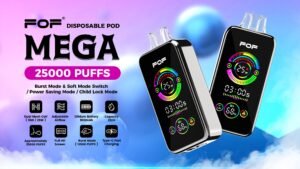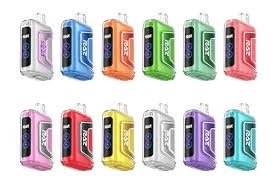Smokers looking to switch face a crucial first decision: disposable vapes or refillable pod systems? This choice impacts your satisfaction, long-term costs, and likelihood of staying smoke-free.
Vape pods are generally better than disposables for regular vapers due to lower long-term costs, greater customization options, and reduced environmental impact. However, disposables offer superior convenience, require zero maintenance, and often provide more consistent flavor experiences, making them ideal for beginners and occasional users.

"Comparison of disposable vape and pod system"
I've helped thousands of smokers switch to vaping over the years, and I've noticed this question comes up constantly. The honest answer depends on your specific needs, lifestyle, and vaping goals. Let me break down the key differences to help you decide which option might work best for your situation.
Are vape pods better than disposables?
Many new vapers are torn between the simplicity of disposables and the versatility of pod systems. Which provides the best experience and value for your specific needs?
Vape pods offer better long-term value with lower per-puff costs (about 30-70% savings over disposables), customizable nicotine strengths and flavors, rechargeable batteries, and reduced environmental impact. However, they require basic maintenance, coil changes, refilling, and have a steeper learning curve compared to disposables.
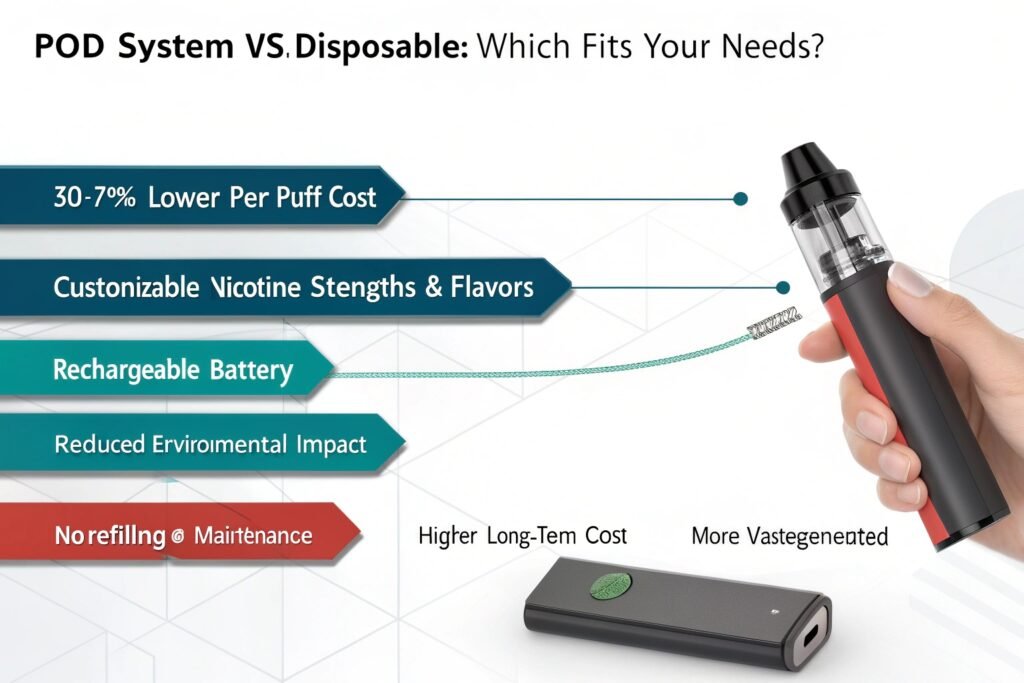
"Refilling a vape pod system"
When I analyze the advantages of pod systems versus disposables, several key factors emerge that help my clients make informed decisions. Looking deeper at the pod system advantages:
Economic Considerations
Pod systems present compelling economic benefits for regular users:
-
Cost comparison breakdown
- Initial investment: Pod systems cost $15-40 upfront vs. $7-15 for disposables
- Running costs: Pods average $0.10-0.15 per ml of e-liquid vs. $0.50-0.70 per ml with disposables
- Long-term savings: A pack-a-day smoker switching to pods typically saves $1,200-1,800 annually compared to disposables
- Break-even point: Most users recover the higher initial pod system cost within 2-3 weeks of regular use
- Consideration: Higher upfront cost deters some users despite dramatic long-term savings
-
Usage frequency economics
- Occasional users (1-3 times weekly): Minimal economic advantage for pod systems
- Regular users (daily): Significant savings with pod systems (30-40%)
- Heavy users (multiple times daily): Maximum economic benefit (50-70% savings)
- Consideration: Your usage pattern dramatically impacts the financial equation
-
Hidden costs
- Replacement coils: Typically $2-4 each, lasting 1-2 weeks
- Battery degradation: Pod device batteries typically maintain good performance for 6-18 months
- Learning curve: Time investment to understand proper maintenance and operation
- Consideration: Factor these costs into your long-term calculations
During my factory visits to evaluate production costs, I discovered that the actual manufacturing cost difference between a disposable and a refillable pod is surprisingly small—often just $2-3. The real price difference comes from the business model, with disposables employing a "printer and ink" strategy that builds ongoing costs into each new purchase rather than separating the device from the consumable.
Performance Factors
Pod systems offer significant performance advantages for those willing to learn:
-
- Wattage adjustment: Many pod systems allow power customization for warmer/cooler vapor
- Airflow control: Adjustable airflow for tighter or looser draws
- Coil options: Different resistance options for varied experiences
- Consideration: Control creates the potential for a more personalized experience
-
- Battery cycles: Rechargeable batteries typically good for 300-500 charges
- Firmware updates: Some advanced pod systems receive feature improvements over time
- Repairability: Limited repair options compared to larger mods but better than disposables
- Consideration: Quality pod systems can last years with proper care
-
- Initial performance: Both pods and disposables start strong
- Mid-life performance: Pod systems maintain consistent performance with proper maintenance
- End-life performance: Disposables often deteriorate as battery depletes; pods maintain performance until battery needs recharging
- Consideration: Pod performance becomes more consistent with user experience
Tommy, one of my distribution partners in Malaysia, conducted a customer satisfaction survey across 500 users who had tried both disposables and pod systems. The results showed that while 78% of new users initially preferred disposables, after three months of use, 65% of regular vapers had switched preference to pod systems, citing performance consistency and cost as the primary factors.
Environmental Impact
The environmental equation heavily favors pod systems:
-
Waste generation comparison
- Monthly waste (disposables): 10-30 complete devices for average users
- Monthly waste (pods): 2-4 small coils or pods, depending on usage
- Battery disposal: Rechargeable pod batteries require proper recycling but much less frequently
- Plastic consumption: Substantially lower with pod systems
- Consideration: Environmental impact may be 10-15x lower with pod systems
-
Recycling challenges
- Disposables: Mixed materials make recycling difficult; lithium batteries require special handling
- Pod systems: Device recycling needed only after extended use; coils still present recycling challenges
- E-liquid containers: Recyclable in many regions
- Consideration: Few vapers have access to proper recycling channels for either option
-
Industry responses
- Manufacturer programs: Some companies developing take-back programs
- Regulatory pressure: Growing governmental concern about disposable waste
- Future outlook: Environmental regulations likely to impact disposables more severely
- Consideration: Industry sustainability efforts primarily focus on pod systems
During a recent industry conference, I was alarmed to learn that an estimated 15-20 million disposable vapes are discarded weekly worldwide—that's enough lithium batteries to power 1,000+ electric vehicles, being sent to landfills every month. This reality has pushed me to more actively promote sustainable options to my clients.
Why do disposable vapes taste better than pods?
Many users report that disposables offer a more intense, satisfying flavor experience compared to pod systems. What's behind this common perception?
Disposable vapes often taste better initially because they use pre-optimized coils and wicks specifically designed for their particular e-liquid, contain slightly higher sweetener levels, utilize ceramic coil technology that produces cleaner flavor, and offer perfectly matched airflow systems. Pod systems can achieve comparable flavor with proper setup and maintenance.
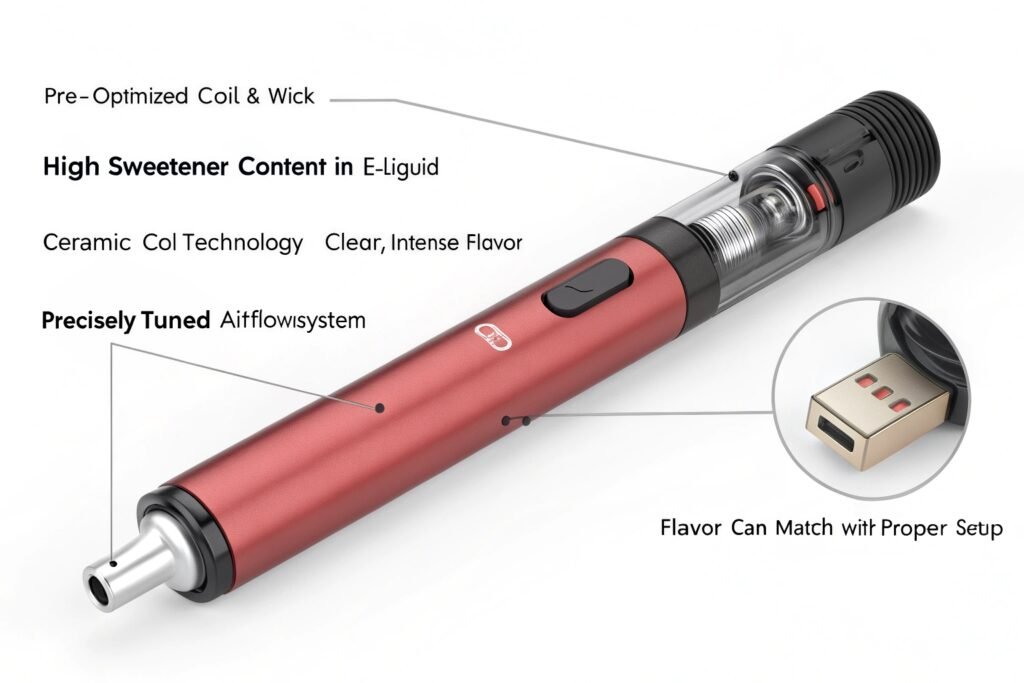
"Integrated design of disposable vape"
After extensive taste testing with our product development team, I've identified several technical factors that explain why many users perceive superior flavor from disposables:
Technical Design Advantages
Disposables benefit from integrated engineering that optimizes flavor:
-
- Purpose-built coils: Disposables' coils are designed specifically for their exact e-liquid
- No break-in period: Factory-saturated wicks provide optimal flavor from first puff
- Consistent power delivery: Precisely regulated output for the specific coil resistance
- Consideration: Factory optimization eliminates variables that pod users must manage
-
E-liquid formulation differences5
- Higher sweetener levels: Typically 15-25% more sweetener than bottled e-liquids
- Premium flavoring percentages: Often using 15-20% flavoring versus 10-15% in bottled e-liquids
- Steeping advantage: Pre-steeped for optimal flavor development
- Consideration: Higher sweetener provides immediate flavor impact but would damage pod coils faster
-
- Integration advantage: Airflow precisely designed for specific coil and power level
- Contamination prevention: Sealed system prevents external elements affecting taste
- Draw consistency: Engineered for consistent draw from first to last puff
- Consideration: Purpose-built airflow systems eliminate the variables of modular designs
During my factory tours in Shenzhen, I've observed the production processes for both disposables and pod systems. Disposable manufacturers can optimize every component around a single flavor profile, while pod system manufacturers must design for compatibility with dozens of different e-liquids. This specialization advantage is similar to how a fixed-focus camera can offer better automatic results than a professional camera with manual settings.
User Experience Factors
Several psychological and practical factors influence flavor perception:
-
Novelty effect
- First-impression impact: New users often try disposables first
- Flavor fatigue: Long-term use of same flavor diminishes perceived intensity
- Comparison baseline: Disposables often compared to cigarettes rather than other vapes
- Consideration: Initial impressions strongly influence ongoing perceptions
-
Maintenance variables
- Zero maintenance: Disposables deliver optimal flavor without user intervention
- Coil priming knowledge: Improper pod coil preparation causes diminished flavor
- Contamination issues: Residual flavors in pods can create undesired mixing
- Consideration: User technique significantly impacts pod flavor performance
-
Psychological factors
- Expectation bias: Higher price-per-ml creates perception of premium experience
- Marketing influence: Disposables heavily marketed as "premium flavor experiences"
- Sunk cost effect: Users who purchase disposables may perceive better value through enhanced flavor perception
- Consideration: Perception of taste is highly subjective and influenced by non-flavor factors
Tommy shared an interesting observation from his retail stores: When conducting blind taste tests with customers (using the same e-liquid in both a quality pod system and a disposable), only about 30% consistently identified the disposable as having better flavor. However, when the devices were visible, nearly 70% claimed the disposable tasted better, suggesting significant psychological factors at play.
Achieving Pod Flavor Optimization
How to bring pod flavor performance closer to disposables:
-
E-liquid selection strategy
- Higher-quality brands: Invest in premium e-liquids with robust flavor profiles
- Freshness considerations: Check production dates; fresher is typically better
- Flavor boosters: Consider adding flavor concentrates for more intensity
- Consideration: E-liquid quality varies dramatically; experimentation is valuable
-
Coil management techniques
- Proper priming: Thorough saturation before first use (5-10 minutes minimum)
- Power optimization: Start low and gradually increase to find flavor sweet spot
- Regular replacement: Change coils at first sign of flavor deterioration
- Consideration: Most flavor issues stem from improper coil management
-
Device maintenance practices
- Regular cleaning: Clean connections and airflow channels weekly
- Dedicated pods: Use separate pods for distinct flavor profiles
- Temperature awareness: Avoid exposing e-liquid to heat and direct sunlight
- Consideration: Cleanliness dramatically impacts flavor clarity
During our product development workshops, we've found that most users can achieve comparable or superior flavor from quality pod systems compared to disposables, but this typically requires education and practice. I've personally trained my staff to demonstrate proper setup techniques that can help customers achieve "disposable-level flavor" from their pod systems.
Which is better, a vape or a pod?
This comparison creates some confusion since "vape" is a broad category. Let's clarify the real question: which format offers the better overall experience for different user types?
Pod systems are generally better for regular users seeking cost efficiency and customization, while disposable vapes are better for absolute beginners, occasional users, and those prioritizing maximum convenience. The "better" choice depends primarily on your usage frequency, technical comfort, budget considerations, and environmental concerns.

"Comparison of different vaping device formats"
From my experience helping thousands transition from smoking, I've found that certain user profiles consistently prefer one format over the other:
User Profile Matching
Different vaping formats serve different user types:
-
Ideal disposable user profile
- Usage pattern: Occasional or situational vaping (social, travel, etc.)
- Technical preference: Minimal interaction with technology
- Budget situation: Values convenience over long-term cost
- Environmental stance: Limited concern about environmental impact
- Consideration: Perfect for the "sometimes" vaper and absolute beginners
-
Ideal pod system user profile
- Usage pattern: Regular daily use replacing smoking
- Technical preference: Comfortable with basic device interaction
- Budget situation: Willing to invest upfront for long-term savings
- Environmental stance: Concerned about reducing waste
- Consideration: Best for committed users seeking sustainable solution
-
Hybrid approach users
- Primary pod use: Day-to-day regular vaping with preferred system
- Strategic disposable use: Travel, emergencies, or situations where charging/refilling is impractical
- Experimental disposable use: Trying new flavors before committing to bottle purchase
- Consideration: Many experienced users leverage both formats for maximum convenience
After tracking customer purchases across our distribution channels, we've observed that approximately 60% of users who start with disposables and continue vaping eventually transition to pod systems within 3-6 months. This migration typically happens once they've established vaping as a regular habit and become more conscious of the ongoing costs.
Decision Making Framework
How to choose based on your personal priorities:
-
If convenience is your top priority
- Maximum convenience: Disposables require zero maintenance
- High convenience with some savings: Prefilled pod systems (JUUL, VUSE, etc.)
- Balanced convenience/cost: Refillable pod systems
- Consideration: How much is your time and effort worth?
-
If cost is your top priority
- Lowest ongoing cost: Refillable pod systems (approximately 70-80% savings vs. disposables)
- Medium cost: Prefilled pod systems (approximately 30-40% savings vs. disposables)
- Highest cost: Disposable systems (premium for convenience)
- Consideration: Frequent users see much more dramatic cost differences
-
If flavor variety is your top priority
- Maximum commercial options: Bottled e-liquids for pod systems (thousands of options)
- Growing but limited selection: Disposables (hundreds of options but still limited)
- DIY potential: Only possible with refillable systems
- Consideration: Pod systems offer vastly more flavor exploration potential
In my consultations with vape shop owners, I recommend they guide customers through these priority considerations rather than immediately pushing one format over another. Tommy implemented this approach in his Malaysian shops and saw a 35% reduction in product returns and exchanges, as customers were better matched to products that aligned with their actual priorities.
Future Market Trends
How the industry is evolving:
-
Regulatory influence
- Disposable regulations: Increasing scrutiny and restrictions worldwide
- Environmental legislation: Growing focus on e-waste and single-use plastics
- Taxation trends: Higher taxes often impact disposables disproportionately
- Consideration: Regulatory landscape generally moving against disposables
-
Technical innovations
- Disposable evolution: Emerging rechargeable/refillable disposable hybrids
- Pod system simplification: Increasingly user-friendly designs closing convenience gap
- Convergence trend: Lines blurring between categories
- Consideration: Both formats becoming more sophisticated
-
Market indicators
- Current boom: Disposables experiencing rapid market growth
- Long-term forecasts: Industry analysts predict regulatory-driven shift back toward refillable systems
- Manufacturer positioning: Major brands investing in both categories
- Consideration: Market volatility makes future availability uncertain
Through my industry connections and participation in trade shows, I've observed manufacturers increasingly developing "hybrid" products that attempt to combine disposable convenience with pod system sustainability. These products—essentially simplified pod systems with disposable components—suggest that even manufacturers recognize that pure disposables may face an uncertain regulatory future.
How many cigarettes are equal to one vape pod?
This common question reflects the desire to understand consumption patterns when switching. Yet the comparison is more nuanced than many realize.
A typical 2ml vape pod with 20mg/ml nicotine strength (40mg total nicotine) roughly equals 20-30 cigarettes in nicotine content, equivalent to 1-1.5 packs. However, this mathematical comparison doesn't account for absorption differences, puffing patterns, and nicotine satisfaction variables that make direct cigarette-to-pod comparisons imprecise.
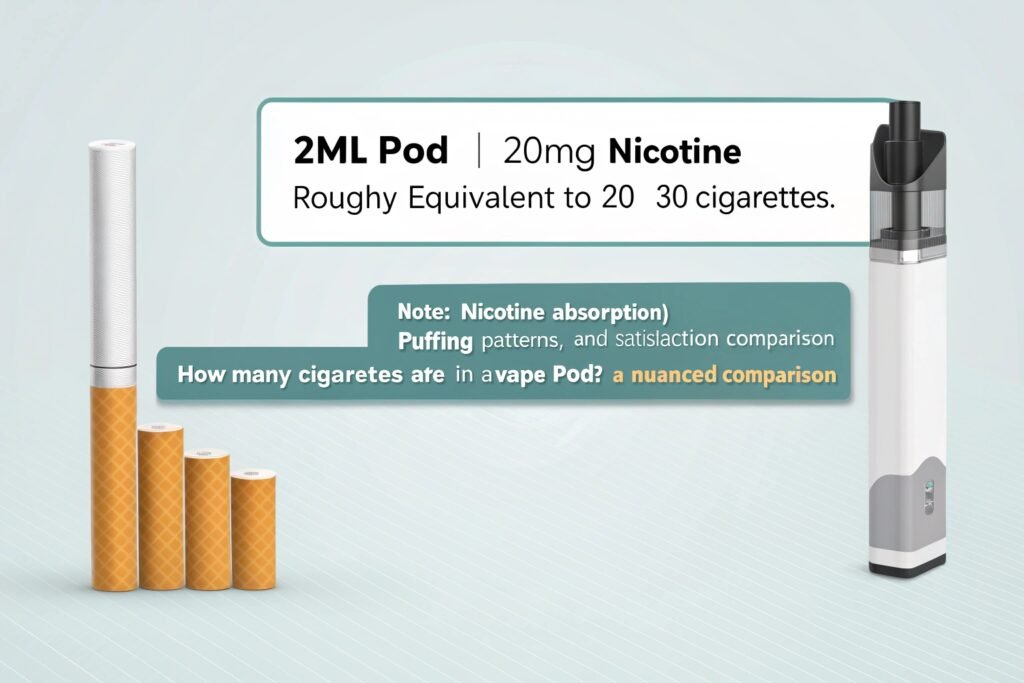
"Nicotine comparison between cigarettes and vape pod"
Drawing from my experience helping smokers transition and our laboratory testing data, I've developed a more comprehensive way to understand the cigarette-to-pod relationship:
Nicotine Content Comparison
Understanding the mathematical relationship:
-
Mathematical equivalency calculations7
- Average cigarette: Contains approximately 8-12mg nicotine, delivers 1-2mg
- Standard pod (2ml): Contains 20-50mg/ml (40-100mg total), delivers about 30-60% of this
- Rough conversion ratio: 2ml pod ≈ 1-1.5 packs of cigarettes (nicotine content)
- Strength variations: 3mg/ml (low), 6mg/ml (medium), 18-50mg/ml (high/salt nic)
- Consideration: Delivery efficiency varies significantly between devices
-
- Small pods: 1-2ml capacity (equivalent to approximately 1 pack)
- Medium pods: 2-3ml capacity (equivalent to approximately 1-2 packs)
- Large pods: 3-5ml capacity (equivalent to approximately 2-3 packs)
- Consideration: Actual capacity may differ slightly from advertised amounts
-
Nicotine absorption differences9
- Cigarettes: Rapid absorption spike within 7-10 seconds
- Freebase nicotine: Slower absorption curve (1-4 minutes to peak)
- Nicotine salts: Faster absorption (30-60 seconds to peak)
- Consideration: Different absorption curves affect satisfaction despite equal nicotine
When I worked with Tommy to develop his customer education materials, we created a visual guide showing how vaping creates a more gradual nicotine delivery curve compared to the sharp peaks and valleys of cigarette use. This helped customers understand why direct cigarette-to-pod comparisons don't perfectly translate to usage patterns, and why they might need to adjust their vaping frequency during the transition period.
Usage Pattern Factors
Real-world usage patterns complicate direct comparisons:
-
Consumption behavior differences
- Cigarettes: Defined beginning and end, usually consumed in one session
- Vaping: Often involves intermittent puffing throughout the day
- Session comparison: 10-15 puffs on a cigarette vs. variable vaping sessions
- Consideration: Vaping behavior typically involves more total puffs but less nicotine per puff
-
Compensation behaviors
- Subconscious adjustment: Users naturally adjust puff frequency and intensity to maintain nicotine levels
- Vape technique variables: Puff duration, lung vs. mouth inhalation, hold time
- Transition period: Initial overconsumption common as users learn their needs
- Consideration: User technique dramatically impacts actual nicotine delivery
-
Environmental influences
- Situation-specific usage: Many vape more in certain contexts (stress, socializing, etc.)
- Accessibility effect: Easier access to device often increases frequency
- Time constraints: Work and social situations may limit usage opportunities
- Consideration: Context affects consumption more with vaping than with cigarettes
Our customer tracking data revealed an interesting pattern: new vapers typically go through one of two phases—either an initial period of overconsumption (because the vape is novel and always accessible) or underconsumption (because they haven't yet developed efficient vaping techniques). After 2-4 weeks, most settle into a more consistent pattern that reflects their actual nicotine needs.
Practical Conversion Guidance
How to translate cigarette habits to vaping expectations:
-
Cigarette consumption mapping
- Light smokers (≤10 cigarettes/day): 2ml pod typically lasts 2-3 days
- Average smokers (11-20 cigarettes/day): 2ml pod typically lasts 1-2 days
- Heavy smokers (20+ cigarettes/day): May use 2-3ml or more daily
- Consideration: Initial consumption often stabilizes after transition period
-
Strength selection strategy
- Light smokers: 6-12mg freebase or 20-35mg salt nicotine
- Average smokers: 12-18mg freebase or 35-50mg salt nicotine
- Heavy smokers: 18mg+ freebase or 50mg+ salt nicotine
- Consideration: Start higher and taper down rather than starting too low
-
Transition benchmarks
- First week: Focus on device familiarity and finding satisfying nicotine level
- First month: Usage patterns typically stabilize; reduction in cigarette cravings
- 2-3 months: Many users naturally begin reducing nicotine strength
- Consideration: Successful transitions often involve temporary overconsumption followed by natural reduction
Working with smokers transitioning to vaping, I've found that one of the most common mistakes is focusing too much on "cigarette counting" rather than satisfaction levels. I advise new users to pay attention to their cravings and satisfaction rather than trying to precisely match their cigarette consumption patterns. For example, Tommy implemented a "satisfaction scale" in his shops rather than asking about cigarette counts, which improved customer success rates significantly.
Conclusion
Both disposable vapes and pod systems have their place depending on your needs. Disposables offer unbeatable convenience and consistent flavor but cost more long-term. Pod systems provide customization, sustainability, and better economics for regular users. Consider your usage patterns, technical comfort, and priorities to make the choice that best supports your smoke-free journey.
-
Explore this link to discover how customization can enhance your vaping experience with pod systems. ↩
-
Learn about the longevity of pod systems and how proper care can extend their lifespan significantly. ↩
-
Understanding performance consistency can help you choose the right pod system for a reliable vaping experience. ↩
-
Understanding coil optimization can enhance your vaping experience by ensuring better flavor and performance. ↩
-
Exploring e-liquid formulation can help you choose the best products for optimal flavor and satisfaction. ↩
-
Learning about airflow engineering can improve your understanding of how to achieve a consistent vaping experience. ↩
-
Explore this resource to grasp how nicotine delivery varies, aiding in better product choices. ↩
-
Learn about pod capacities to understand how they relate to traditional smoking, enhancing your vaping experience. ↩
-
Understanding nicotine absorption can help you make informed choices about smoking and vaping products. ↩


